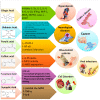Anticancer, Cardio-Protective and Anti-Inflammatory Potential of Natural-Sources-Derived Phenolic Acids
- PMID: 36364110
- PMCID: PMC9656250
- DOI: 10.3390/molecules27217286
Anticancer, Cardio-Protective and Anti-Inflammatory Potential of Natural-Sources-Derived Phenolic Acids
Abstract
Phenolic acids (PAs) are one of the utmost prevalent classes of plant-derived bioactive chemicals. They have a specific taste and odor, and are found in numerous medicinal and food plants, such as Cynomorium coccineum L., Prunus domestica (L.), and Vitis vinifera L. Their biosynthesis, physical and chemical characteristics and structure-activity relationship are well understood. These phytochemicals and their derivatives exert several bioactivities including but not limited to anticancer, cardioprotective, anti-inflammatory, immune-regulatory and anti-obesity properties. They are strong antioxidants because of hydroxyl groups which play pivotal role in their anticancer, anti-inflammatory and cardioprotective potential. They may play significant role in improving human health owing to anticarcinogenic, anti-arthritis, antihypertensive, anti-stroke, and anti-atherosclerosis activities, as several PAs have demonstrated biological activities against these disease during in vitro and in vivo studies. These PAs exhibited anticancer action by promoting apoptosis, targeting angiogenesis, and reducing abnormal cell growth, while anti-inflammatory activity was attributed to reducing proinflammatory cytokines. Pas exhibited anti-atherosclerotic activity via inhibition of platelets. Moreover, they also reduced cardiovascular complications such as myocardial infarction and stroke by activating Paraoxonase 1. The present review focuses on the plant sources, structure activity relationship, anticancer, anti-inflammatory and cardioprotective actions of PAs that is attributed to modulation of oxidative stress and signal transduction pathways, along with highlighting their mechanism of actions in disease conditions. Further, preclinical and clinical studies must be carried out to evaluate the mechanism of action and drug targets of PAs to understand their therapeutic actions and disease therapy in humans, respectively.
Keywords: anti-arthritis; anti-carcinogenic; antioxidant; hypertension; phenolic acids; stroke.
Conflict of interest statement
The authors declare no conflict of interest.
Figures










Similar articles
-
Role of Phenolic Compounds in Human Disease: Current Knowledge and Future Prospects.Molecules. 2021 Dec 30;27(1):233. doi: 10.3390/molecules27010233. Molecules. 2021. PMID: 35011465 Free PMC article. Review.
-
Phenolic acids from medicinal and edible homologous plants: a potential anti-inflammatory agent for inflammatory diseases.Front Immunol. 2024 Jun 21;15:1345002. doi: 10.3389/fimmu.2024.1345002. eCollection 2024. Front Immunol. 2024. PMID: 38975345 Free PMC article. Review.
-
Genkwanin: An emerging natural compound with multifaceted pharmacological effects.Biomed Pharmacother. 2023 Sep;165:115159. doi: 10.1016/j.biopha.2023.115159. Epub 2023 Jul 21. Biomed Pharmacother. 2023. PMID: 37481929 Review.
-
Evaluation of phenolic composition, antioxidant, anti-inflammatory and anticancer activities of Polygonatum verticillatum (L.).J Integr Med. 2018 Jul;16(4):273-282. doi: 10.1016/j.joim.2018.04.005. Epub 2018 Apr 18. J Integr Med. 2018. PMID: 29706573
-
Phenolic Acid Profiling, Antioxidant, and Anti-Inflammatory Activities, and miRNA Regulation in the Polyphenols of 16 Blueberry Samples from China.Molecules. 2017 Feb 18;22(2):312. doi: 10.3390/molecules22020312. Molecules. 2017. PMID: 28218703 Free PMC article.
Cited by
-
Isorhamnetin alleviates symptoms and inhibits oxidative stress levels in rats with pulmonary arterial hypertension.Iran J Basic Med Sci. 2024;27(12):1616-1623. doi: 10.22038/ijbms.2024.75860.16421. Iran J Basic Med Sci. 2024. PMID: 39539446 Free PMC article.
-
Evaluation of the Phenolic Composition and Biological Activities of Six Aqueous Date (Phoenix dactylifera L.) Seed Extracts Originating from Different Countries: A Comparative Analysis.Foods. 2023 Dec 29;13(1):126. doi: 10.3390/foods13010126. Foods. 2023. PMID: 38201154 Free PMC article.
-
Comprehensive Determination of the Phenolic Compound Contents and Antioxidant Potentials of Leaves and Roots of Peucedanum japonicum Harvested from Different Accessions and Growth Periods.ACS Omega. 2024 Sep 25;9(40):41616-41628. doi: 10.1021/acsomega.4c05561. eCollection 2024 Oct 8. ACS Omega. 2024. PMID: 39398175 Free PMC article.
-
The Impact of Lighting Treatments on the Biosynthesis of Phenolic Acids in Black Wheat Seedlings.Foods. 2024 Aug 9;13(16):2499. doi: 10.3390/foods13162499. Foods. 2024. PMID: 39200426 Free PMC article.
-
New Insights into Aspirin's Anticancer Activity: The Predominant Role of Its Iron-Chelating Antioxidant Metabolites.Antioxidants (Basel). 2024 Dec 29;14(1):29. doi: 10.3390/antiox14010029. Antioxidants (Basel). 2024. PMID: 39857363 Free PMC article. Review.
References
-
- Rasouli H., Farzaei M.H., Khodarahmi R. Polyphenols and their benefits: A review. Int. J. Food Prop. 2017;20:1700–1741. doi: 10.1080/10942912.2017.1354017. - DOI
-
- Pereira D.M., Valentão P., Pereira J.A., Andrade P.B. Phenolics: From Chemistry to Biology. Molecules. 2009;14:2202–2211. doi: 10.3390/molecules14062202. - DOI
-
- Goleniowski M., Bonfill M., Cusido R. Phenolic Acids 63, in Phenolic Acids. In: Ramawat K., Mérillon J.M., editors. Natural Products. Springer; Berlin/Heidelberg, Germany: 2013.
Publication types
MeSH terms
Substances
Grants and funding
LinkOut - more resources
Full Text Sources
Medical

